
Inocybe hystrix is an agaric fungus in the family Inocybaceae. It forms mycorrhiza with surrounding deciduous trees. Fruit bodies are usually found growing alone or in small groups on leaf litter during autumn months. Unlike many Inocybe species, Inocybe hystrix is densely covered in brown scales, a characteristic that aids in identification. The mushroom also has a spermatic odour that is especially noticeable when the mushroom is damaged or crushed.

Cortinarius caperatus is an edible mushroom of the genus Cortinarius found in northern regions of Europe and North America. It was known as Rozites caperata for many years before genetic studies revealed that it belonged to the genus Cortinarius. The fruit bodies appear in autumn in coniferous and beech woods as well as heathlands in late summer and autumn. The ochre-coloured cap is up to 10 cm (4 in) across and has a fibrous surface. The clay-colored gills are attached to the stipe under the cap, and the stipe is whitish with a whitish ring. The Latin specific name, caperatus, means wrinkled, and refers to the distinctive texture of the cap. The flesh has a mild smell and flavor.

Phlegmacium triumphans, also known as the birch webcap, or yellow girdled webcap is a basidiomycete mushroom in the family Cortinariaceae. It is found in Europe and regarded as edible by some authorities, although others call it suspect and it resembles inedible species.

Cortinarius violaceus, commonly known as the violet webcap or violet cort, is a fungus in the webcap genus Cortinarius native across the Northern Hemisphere. The fruit bodies are dark purple mushrooms with caps up to 15 cm (6 in) across, sporting gills underneath. The stalk measures 6 to 12 centimetres by 1 to 2 cm, sometimes with a thicker base. The dark flesh has a smell reminiscent of cedar wood. Forming symbiotic (ectomycorrhizal) relationships with the roots of various plant species, C. violaceus is found predominantly in conifer forests in North America and deciduous forests in Europe.

Cortinarius varius, also known as the contrary webcap, is a basidiomycete mushroom of the genus Cortinarius. The mushroom has orangish-yellow caps that reach up to 10 cm (3.9 in) in diameter, and thick club-shaped stems up to 10 cm (3.9 in) long.
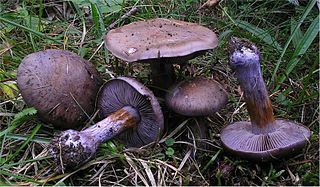
Thaxterogaster purpurascens is a species of mushroom producing fungus in the family Cortinariaceae. It is commonly known as the bruising webcap.

Cortinarius infractus, commonly known as the sooty-olive Cortinarius or the bitter webcap, is an inedible basidiomycete mushroom of the genus Cortinarius. The fungus produces sooty-olive fruit bodies with sticky caps measuring up to 13 cm (5.1 in) in diameter. The fruit bodies contains alkaloids that inhibit the enzyme acetylcholinesterase.
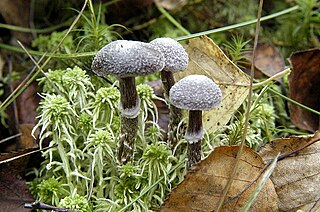
Cortinarius hemitrichus, also known as the frosty webcap, is a basidiomycete mushroom of the genus Cortinarius. Young mushrooms are characterized by their brown cone-shaped caps covered with dense white fibrils.

Cortinarius delibutus, also known as the bluegill webcap or the yellow webcap, is a basidiomycete fungus of the genus Cortinarius. The fruit bodies are medium-sized, with shiny yellow caps on a sticky, yellow-banded club-shaped stem. The mushroom is found in Europe and North America, usually near birch or beech trees.

Cortinarius cinnamomeus, also known as the cinnamon webcap, is a basidiomycete mushroom of the genus Cortinarius. The fungus produces brown fruit bodies with caps up to 6 cm (2.4 in) wide and stems up to 12 cm (4.7 in) long. The closely crowded gills underside the cap are initially yellow before turning brown. Cortinarius cinnamomeus is common in damp places in coniferous forests. It is distributed throughout the temperate zone of the Northern Hemisphere.

Cortinarius anomalus, also known as the variable webcap, is a basidiomycete fungus of the genus Cortinarius. It produces a medium-sized mushroom with a grayish-brown cap up to 5 cm (2 in) wide, gray-violet gills and a whitish stem with pale yellow belts below. The mushroom grows solitarily or in scattered groups on the ground in deciduous and coniferous forests. It is found throughout the temperate zone of the northern hemisphere.
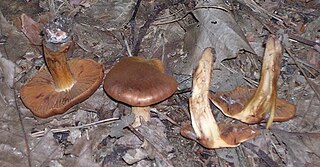
Cortinarius orellanus, commonly known as the fool's webcap or fools webcap, is a species of deadly fungus in the family Cortinariaceae native to Europe. Within the genus it belongs to a group known as the Orellani, all of which are highly toxic—eating them results in kidney failure, which is often irreversible. The mushroom is generally tan to brown all over.
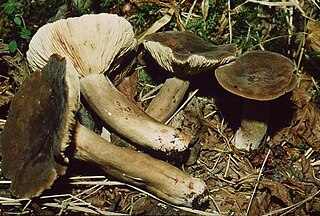
Lactarius fuliginosus, commonly known as the sooty milkcap, is a species of fungus in the family Russulaceae. The medium-sized fruit bodies have velvety, grayish-brown caps and crowded gills. It is found in deciduous forests of Asia, Europe, and North America.

Phaeocollybia christinae, commonly known as Christina's rootshank, is a species of fungus in the family Cortinariaceae. Found in the woodlands of Europe and eastern North America, it typically grows in sandy soil near conifer trees, especially spruce. The fruit bodies are characterized by a brownish cap with a pointed umbo, and a long stem that extends deeply into the soil.

Cortinarius camphoratus, commonly known as the goatcheese webcap, is an agaric fungus in the family Cortinariaceae. The fungus is found in Europe and North America, where its fruit bodies (mushrooms) grow on the ground in a mycorrhizal association with spruce and firs in coniferous forests. Mushrooms are characterized by pale blue lilac colors when young, and a strong distinctive odor. Sources disagree as to the edibility of the mushroom, but they are generally not recommended for eating.

Imperator torosus, commonly known as the brawny bolete, is a species of bolete fungus in the family Boletaceae. It is native to southern Europe east to the Caucasus and Israel. It is generally associated with deciduous trees such as hornbeam, oak and beech in warm, dry locales. Although generally rare in Europe, it appears to be relatively common in Hungary. Appearing in summer and autumn on chalky soils, the stocky fruit bodies have an ochre cap up to 20 cm (8 in) across, yellow pores on the cap underside, and a wine-red to brown or blackish stipe up to 6–15 cm (2.4–5.9 in) long by 3–6 cm (1.2–2.4 in) wide. The pale yellow flesh changes to different colours when broken or bruised depending on age; younger mushrooms become reddish, and older ones additionally take on bluish tones.
Phlegmacium boreicyanites is a species of fungus in the family Cortinariaceae
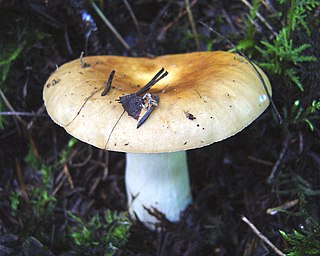
Russula mustelina, commonly known as the russet brittlegill, is a basidiomycete mushroom of the genus Russula native to Europe and North America. Swedish mycologist Elias Magnus Fries described the species in his 1838 book Epicrisis Systematis Mycologici seu Synopsis Hymenomycetum.

Lactarius trivialis is a species of mushroom belonging to the genus Lactarius. The fungus is most commonly found in Scandinavia. The colour of the mushroom's cap can range from a light brown colour, to dark purple. The species has a total of five subtaxa. It was discovered and first recorded in the year 1838 by Elias Magnus Fries, in his book, Epicrisis Systematis Mycologici.

Coprinopsis nivea is a species of mushroom producing fungus in the family Psathyrellaceae. It is commonly known as the snowy inkcap.



















